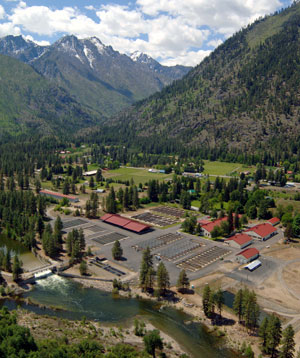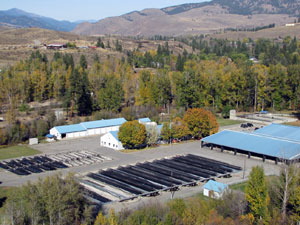Federal Columbia River Power System Hatchery Program
FCRPS Home | Hydrosystem | Hatcheries | Tributary Habitat Program | Tributary Habitat RME | Fish Accords
Reclamation funds three hatcheries as mitigation for fish production lost due to the construction and operation of Grand Coulee Dam. These hatcheries are collectively known as the Leavenworth Complex.

The hatchery programs are operated by the USFWS and include production of spring Chinook salmon at Leavenworth National Fish Hatchery (NFH), summer Chinook salmon at Entiat NFH, and spring Chinook salmon and summer steelhead at Winthrop NFH. These three hatcheries are part of an extensive FCRPS hatchery program funded by BPA, USACE, and Reclamation.
In addition to mitigation, hatchery conservation programs for ESA-listed upper Columbia, middle Columbia, and Snake River salmon and steelhead help preserve and rebuild genetic resources and assist in promoting recovery.
There are also safety-net programs to preserve genetic resources and reduce short-term extinction risk for at-risk populations such as Snake River sockeye. The following strategies are pursued:
- Fund hatcheries and adopt programmatic criteria for funding decisions on mitigation programs for the FCRPS that incorporates current best management practices; and
- Undertake/fund reforms to ensure that hatchery programs funded by the Action Agencies as mitigation for the FCRPS are not impeding recovery.
RPA Action 39: ESA Consultation
Reasonable and Prudent Alternative (RPA) Action 39 of the BiOp directs Action Agencies to continue funding hatchery programs and requires site-specific ESA consultations for the operation and maintenance of hatcheryWinthrop National Fish Hatchery programs. The process for these consultations consists of the hatchery operators and funding agencies preparing a Hatchery Genetic and Management Plan (HGMP) that details the operation and maintenance activities associated with production of the fish as well as the plan to manage the interactions of the hatchery fish with wild fish listed under the ESA. The HGMP is submitted to NOAA Fisheries, who then uses the information to prepare a biological opinion evaluating the effects of the hatchery program on ESA-listed fish populations. The status of ESA consultation for each of Reclamation’s hatcheries is as follows:
Leavenworth National Fish Hatchery Spring Chinook Salmon Program – The HGMP was submitted to NOAA Fisheries by USFWS in July 2009. Subsequently, a Section 7 ESA consultation was completed with USFWS on effects to bull trout and other USFWS jurisdiction species, thereby clarifying the proposed action. The HGMP was revised and submitted in March 2011. NOAA Fisheries indicated the consultation package was sufficient for formal consultation in June 2011. In 2012, NOAA Fisheries provided a draft BiOp, USFWS and Action Agencies provided comments. The BiOp is in review at NOAA Fisheries.

Entiat National Fish Hatchery Summer Chinook Salmon Program – The Entiat NFH summer Chinook Program previously raised and released spring Chinook salmon that were found to be a limiting factor to population viability of listed spring Chinook salmon. Spring Chinook salmon releases were discontinued in 2008 and the mitigation program was replaced with unlisted summer Chinook salmon, thereby eliminating effects of Entiat National Fish Hatchery spring Chinook salmon on the spawning grounds. The HGMP was submitted by USFWS in July 2009 to NOAA Fisheries, and an addendum was provided in 2012. NOAA Fisheries accepted the HGMP for this program as sufficient for formal ESA consultationin March 2009. In 2012, NOAA Fisheries provided a draft BiOp, USFWS and Action Agencies provided comments. A final BiOp was received April 19, 2013.
Winthrop National Fish Hatchery Summer Steelhead Program – USFWS submitted an HGMP in July 2009. Discussions were sparked by a series of “Value Planning” meetings hosted by Reclamation, and subsequent discussions made considerable progress in resolving a series of difficult challenges. These discussions continued in 2012, and issues have been resolved. Co-managers (USFWS, Douglas County Public Utilities District (PUD), and Washington Department of Fish and Wildlife (WDFW)) developed a framework to evaluate and manage steelhead programs in the Methow basin comprehensively. USFWS revised the HGMP and submitted it to NOAA Fisheries in November 2012. NOAA Fisheries accepted the HGMP as sufficient in March 2013 and is preparing a draft BiOp.
Winthrop National Fish Hatchery Spring Chinook Salmon Program – USFWS submitted an HGMP to NOAA Fisheries in July 2009. Informal discussions resolved a series of difficult challenges in 2012. USFWS revised the HGMP and submitted it to NOAA Fisheries in November 2012. NOAA Fisheries accepted the HGMP as sufficient in March 2013 and is preparing a draft BiOp.
RPA Action 40: Hatchery Reforms
RPA Action 40 outlines specific reforms to be included in the ESA consultations. Specific to Winthrop NFH, RPA Action 40 includes measures to transition to local steelhead broodstock and manage the number of Winthrop NFH-produced steelhead on the spawning grounds. These measures are to be identified through ESA consultation, and implementation is contingent on a finding, in consultation with NOAA, that the measures are biologically and economically feasible and effective.
The Winthrop NFH is transitioning to local broodstock by collecting more adults from the Winthrop Basin via hatchery volunteers and angling. The program began in 2008 and has transitioned over time to all production from local broodstock in 2012. The release goal of 100,000 fish annually continued throughout the transition with the remainder coming from traditional broodstock from Wells Dam collection. Raising juvenile steelhead from local broodstock requires longer-term (two-year) rearing of juvenile steelhead, compared to a one-year rearing cycle for Wells Dam stock. Study plans were established with NOAA Fisheries to evaluate the survival benefits of the local broodstock and two-year rearing strategy. Preliminary results indicate the success of this strategy, with better survival and migratory performance under the two-year rearing regime.
In 2011, Reclamation sponsored a series of facilitated meetings, through a “Value Planning” process, with Methow River Basin stakeholders to discuss local broodstock collection and possible hatchery reforms to more effectively manage returning adults. Foghorn Dam at the hatchery intake had previously been suggested as a likely place to intercept returning adult steelhead but does not effectively block fish for collection. A weir at Foghorn Dam had been suggested as a means to collect fish for management, but this is a difficult and controversial solution. The Value Planning process included a coordination meeting in February 2011; a larger, facilitated “Group Objectives And Logistics (GOAL)” meeting to develop a problem statement, sideboards, and criteria; and a focused workgroup session to develop proposals to collect broodstock and effectively manage returning adults. Entities involved in these meetings included Reclamation, BPA, USFWS, WDFW, Yakama Nation, Douglas County PUD, Upper Columbia Salmon Recovery Board, the Confederated Tribes of the Colville Reservation, Grant County PUD, and Chelan County PUD.
In the short term, the team recommended collaboratively developing and implementing a cooperative plan using:
- a suite of actions that could use existing infrastructure to collect fish such as increased angling effort, conservation fisheries, seining/netting, and release strategies in concert with increased monitoring;
- temporary structures such as picket panel weirs or pound nets throughout the basin to capture returning adults.
These efforts will be monitored to evaluate the efficacy of these measures to meet adult management and broodstock collection objectives. Furthermore, project proponents recommended further evaluation of structural solutions such as construction of a weir at Foghorn Dam or other locations to collect fish.
Based on the Project Alternatives Solution Study, Reclamation funded a scope of work within the funding agreement with USFWS to enable implementation of Proposals 1 and 2 to increase local broodstock collection, enhance returning hatchery fish management, and monitor these efforts, beginning in 2013.
Other reforms at Winthrop NFH included a project to remove and replace outdated structures and install new holding and rearing ponds for sorting and spawning adult fish. This project was considered by the technical evaluation team and bids were solicited in 2010, a contract was awarded in 2011, and construction was completed in 2012.
| Related Documents | |
| 04/2013 | Entiat Final Biological Opinion PDF 2.54 mb |
| 09/2012 | (Reclamation) Project Alternatives Solution Study PDF 1.37 mb |
| 04/2012 | Entiat HGMP Addendum PDF 776 kb |
| 07/2009 | Entiat HGMP PDF 936 kb |
| Related Information | |
| FCRPS Hatchery Information HTML | |
| 09/2010 | Columbia River Hatcheries: An Evolving Role (BPA) PDF 1.93 mb |
| 02/2009 | Report to Congress on Columbia River Basin Hatchery Reform (Columbia River Hatchery Scientific Review Group) PDF 1.86 mb |
Contact
Public Affairs Office
pninfo@usbr.gov
208-378-6231
Bureau of Reclamation
Columbia-Pacific Northwest Region
1150 N Curtis Road, Suite 100
Boise, Idaho 83706

